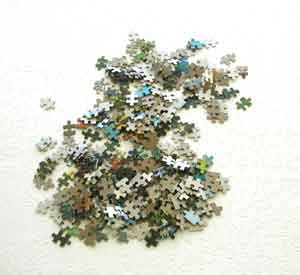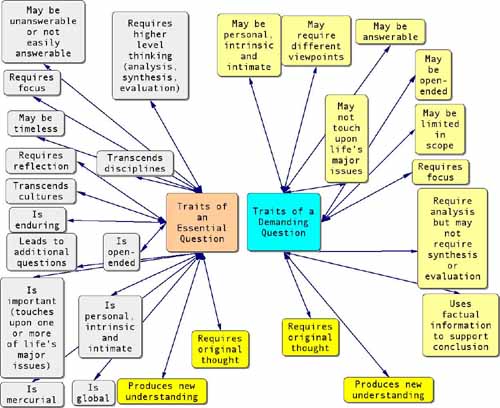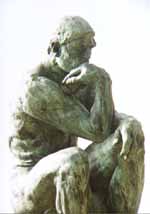When is an essential question actually essential?
When will a demanding question suffice?
Back when Grant Wiggins and the Coalition of Essential Schools introduced and popularized the term "essential question" two decades ago, an essential question was important and deep enough to provide focus for an entire year's study.
- "What causes some to want to explore the unknown even when that exploration might entail loss, pain, hardship and death?"
Over the next twenty years, the term spread far and wide as many curriculum leaders urged teachers to build their lessons and units around such questions.
While it is certainly a worthy goal to focus much student learning around important issues and questions of great import, it is probably unrealistic to impose such high expectations on daily lesson planning. Essential questions serve well to organize major units of study, while demanding questions may better match the realities and possibilities of daily practice. 
Students synthesize their daily work on demanding questions like jigsaw pieces until a picture emerges that captures the essence of an essential (unit) question.
A demanding question requires thought at the top of Bloom's Taxonomy but need not meet some of the same tests of significance we apply to essential questions.
Tests of Significance
To merit the label "essential" a question must meet some very rigorous criteria or tests of significance. It must pass the test of "So what?"
Many teachers fall into the trap of thinking an essential question is a big question, but that is not a sufficient or very important quality of an essential question.
All of the following are big questions that do not rise to the level of "essential" because they do not require much more than information-gathering and summarizing.
- What happened in World War One?
- What were da Vinci's accomplishments?
- What route did Captain Flinders follow on his voyages?
- What were Napoleon's Codes?
Those four questions are large in scope but they do not require thought on the top of Bloom's Taxonomy and they do not pass the test of "So what?" They could each be converted into essential questions by adding a twist that would require judgment, interpretation, synthesis and thought.
- In what ways did the events of World War One help set the scene for World War Two?
- How did da Vinci's character shape his contributions?
- Why do you suppose Flinders managed to circumnavigate Australia before any other European?
- To what extent do we owe Napoleon a debt of gratitude as a result of his Codes?
Most essential questions are interdisciplinary in nature. They usually cut across lines created by schools and scholars to mark the terrain of departments and disciplines.
Essential questions usually probe the deep and often confounding issues confronting us - complex and baffling matters that elude simple answers: Life - Death - Marriage - Identity - Purpose - Betrayal - Honor Integrity - Courage - Temptation - Faith - Leadership - Addiction Invention - Inspiration.
What are the traits of an essential question?
- The question probes a matter of considerable importance.
- The question requires movement beyond understanding and studying - some kind of action or resolve - pointing toward the settlement of a challenge, the making of a choice or the forming of a decision.
- The question cannot be answered by a quick and simple “yes” or “no” answer.
- The question probably endures, shifts and evolves with time and changing conditions - offering a moving target in some respects.
- The question may be unanswerable in the ultimate sense.
- The question may frustrate the researcher, may prove arid rather than fertile and may evade the quest for clarity and understanding.
Unfortunately, the term is often bandied about with little rigor, definition or clarity so that many pedestrian and insignificant questions slip in under the term simply because they are large, sweeping and grand in some respects.
Essential questions are not simply BIG questions covering lots of ground.
To trace the decline and fall of the Roman Empire is a grand task, an enormous task, but it hardly makes for an essential question because it lacks focus and fails to move past description to analysis, synthesis or evaluation. If we were to ask instead how our modern state, be it Australia, the United States or Canada, might avoid a decline like the one experienced by the Roman Empire, we would convert mere collecting and description into a much more important and intriguing task.
It is not the sweep or the grandeur of the question that matters so much as the significance of the issues addressed. Matters of import are the crux of the matter.
Demanding Questions Serve Daily Practice and Lesson Planning
Training in essential questions sometimes imposes a heavy burden on librarians and teachers who are led to believe they must somehow reach the above Tests of Significance on each day of 5th Grade science or 8th Grade social studies. Demanding questions are a much more reasonable expectation to apply to daily lesson planning, as the teacher orchestrates a series of lessons that ultimately help students to "piece together" answers to unit questions over a number of days and weeks.
How do they differ? It helps to place the two side by side in a cluster diagram like the one below where their traits stand in clear contrast, but the diagram is quite large in full scale (when you click on the miniature below to open a new window with the original diagram).

You can quickly see that essential questions and demanding questions share two prime traits:
- They require original thought.
- The produce new understanding.
Other than those two traits, they are quite different, as the word "may" appears in seven of the traits associated with demanding questions - an indication that a teacher has more latitude when generating such questions. Because demanding questions do not carry with them as heavy a significance or import load as essential questions, they are easier to formulate and match to lesson objectives.
Note: Much of the input for this particular cluster diagram came from a summer planning workshop with a group of media specialists and technology specialists from the Millburn Township Schools in New Jersey. Thanks goes to the group for their good thinking and help with this model.
For a second version of this diagram submitted by Kendra Grant of Strategic Transitions (Inspiration software) in Canada, click here to go to the end of this article.
Traits of a Demanding Question
- Requires focus
- Requires original thought
- Produces new understanding
- Requires analysis but may not require synthesis or evaluation
- May not touch upon life's major issues
- May require different viewpoints
- May be answerable
- May be open-ended
- May be personal, intrinsic and intimate
- May be limited in scope
- May use factual information to support conclusion
Examples of Demanding Questions
A good exercise to learn how to differentiate between essential and demanding questions is to scroll through a list of questions and label them as E or D. This works well as a group exercise, as individuals can compare notes when they are done and the ensuing discussion will help each person to clarify their personal grasp of the two types of question.
A source of questions for practice can be found in "The Great Question Press" at http://questioning.org/questionpress.html. One illustrative chunk is reproduced below:
|
Rating
E or D |
| 1. Imagine the governor of your state has asked your team to come up with a plan to reduce the damage being done by acid rain to state forests. After reviewing what has been done in the past, what would be the main thrust of your proposal to restore healthy forests and moderate the impacts of acid rain? How can you improve on past efforts? |
|
| . |
|
| 2. Taking advantage of 20-20 hindsight, what do you think General X should have done differently during the Battle of Some Big River to reduce casualties and block the enemy from winning the war? |
|
| . |
|
| 3. Where did the story bog down, falter and disappoint you? What could Winton have done differently, do you suppose, to improve upon those sections? |
|
| . |
|
| 4. How could you build a package to reduce the chances of an egg breaking upon impact after tumbling from the basket of a hot air balloon at 125 feet above the ground? |
|
Rating the Above Questions
Different people might reasonably disagree on how to rate the questions above.
1. Essential - Reversing the damage of acid rain to restore healthy forests is certainly one of the essential questions facing quite a few nations.
2. Demanding - At the time, the question was essential for those planning the battle, but now is is an exercise in hypothetical thinking, challenging but no longer likely to impact real life.
3. Demanding - Considering one writer's strategies and methods is an important and rigorous thinking task, but it does not touch upon the deepest issues of life unless you are the writer Tim Winton, himself, for then these questions would seem essential.
4. Demanding - Another thought-provoking exercise requiring invention but it is an exercise, not a real life survival task.

Click on the Diagram above to Enlarge
After reading Jamie McKenzie's insightful article on Essential and Demanding Questions I wanted to create a visual organizer that supported my understanding. In order to compare and contrast the two types of questions I created one top down and one bottom up tree. This type of tree diagram allows me to "read" the information left to right and I can quickly see that Essential Questions more involved and detailed that the Demanding Questions, simply by the number of traits.
Next I positioned the two tree diagrams near each other and included colour coded symbols so that I could easily see what traits are the same, what traits are similar and what traits are completely different. In addition I added a checklist feature so I could use the organizer to help me identify Essential or Demanding Questions and/or create them. In addition, by linking the two ideas to the title, I also have a sequential written outline (with checklist) that I can use to identify/build questions.
To download a copy of Kendra's Inspiration diagram
right mouse (Windows) or ctrl click (Mac) here and save
the file to your computer.
 The Question Mark
The Question Mark



